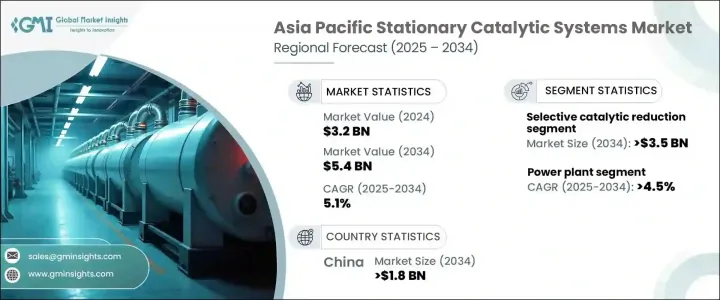PUBLISHER: Global Market Insights Inc. | PRODUCT CODE: 1685156

PUBLISHER: Global Market Insights Inc. | PRODUCT CODE: 1685156
Asia Pacific Stationary Catalytic Systems Market Opportunity, Growth Drivers, Industry Trend Analysis, and Forecast 2025 - 2034
Asia Pacific Stationary Catalytic Systems Market, valued at USD 3.2 billion in 2024, is set for steady expansion with a projected CAGR of 5.1% between 2025 and 2034. Rapid industrialization, surging energy demand, and stringent emission regulations are driving the widespread adoption of these systems across industries. Governments in the region are enforcing stricter environmental policies to curb harmful emissions, pushing industries to invest in advanced catalytic solutions. The increasing reliance on energy-intensive manufacturing processes, particularly in heavy industries like power generation, cement, and petrochemicals, is accelerating demand for emission control technologies.

With rising concerns over air quality and climate change, industries are under pressure to deploy sustainable solutions that minimize nitrogen oxide (NOx) emissions and support the transition to cleaner energy. The market's growth trajectory is further reinforced by technological advancements, including compact and efficient catalytic system designs that enhance operational efficiency while ensuring compliance with evolving regulatory standards. Integrated solutions combining oxidation catalysts with catalytic reduction technologies are gaining traction, offering a more comprehensive approach to emission control.
| Market Scope | |
|---|---|
| Start Year | 2024 |
| Forecast Year | 2025-2034 |
| Start Value | $3.2 Billion |
| Forecast Value | $5.4 Billion |
| CAGR | 5.1% |
Based on technology, the selective catalytic reduction (SCR) segment is poised to generate USD 3.5 billion by 2034. SCR technology, known for its superior NOx reduction capabilities and compliance with ammonia emission limits, is becoming a preferred choice across various industries. Industries are increasingly investing in SCR systems to meet regulatory standards and improve overall operational efficiency. Continuous advancements in system design, such as compact configurations and high-efficiency catalysts, are further accelerating adoption. By integrating oxidation catalysts, SCR systems not only curtail NOx emissions but also effectively reduce carbon monoxide (CO), volatile organic compounds (VOCs), and particulate matter, making them a highly efficient solution for meeting stringent emission mandates. These systems play a critical role in improving air quality while ensuring industrial facilities operate within regulatory guidelines.
The power plant sector is expected to expand at a CAGR of 4.5% through 2034, driven by rising industrial activities and increasing energy efficiency requirements. The growing implementation of emission control systems stems from strict government regulations aimed at reducing NOx and CO emissions. Regulatory frameworks are becoming more rigorous, with authorities imposing emission limits and financial penalties for non-compliance, compelling power plants to integrate advanced catalytic systems. As demand for cleaner energy solutions intensifies, power generation facilities are actively adopting innovative technologies to minimize environmental impact while maintaining operational efficiency. The integration of cutting-edge catalytic solutions is crucial for industries seeking to balance energy production with sustainability objectives.
China stationary catalytic systems market is projected to generate USD 1.8 billion by 2034, fueled by the country's expanding manufacturing sector and the continuous growth of coal-fired power plants to meet escalating electricity demand. Regulatory agencies are enforcing stringent emission reduction targets, driving industries to deploy advanced catalytic systems. With rising environmental and health concerns, businesses in high-energy-consuming sectors such as cement production, heavy metal manufacturing, and refining are turning to stationary catalytic systems to mitigate their ecological footprint. The market outlook remains robust, supported by ongoing technological innovations in emission control and increased investments in sustainable industrial solutions.
Table of Contents
Chapter 1 Methodology & Scope
- 1.1 Market definitions
- 1.2 Base estimates & calculations
- 1.3 Forecast calculation
- 1.4 Data sources
- 1.4.1 Primary
- 1.4.2 Secondary
- 1.4.2.1 Paid
- 1.4.2.2 Public
Chapter 2 Industry Insights
- 2.1 Industry ecosystem analysis
- 2.2 Regulatory landscape
- 2.3 Industry impact forces
- 2.3.1 Growth drivers
- 2.3.2 Industry pitfalls & challenges
- 2.4 Growth potential analysis
- 2.5 Porter's analysis
- 2.5.1 Bargaining power of suppliers
- 2.5.2 Bargaining power of buyers
- 2.5.3 Threat of new entrants
- 2.5.4 Threat of substitutes
- 2.6 PESTEL analysis
Chapter 3 Competitive Landscape, 2024
- 3.1 Introduction
- 3.2 Strategic dashboard
- 3.3 Innovation & sustainability landscape
Chapter 4 Market Size and Forecast, By Technology, 2021 – 2034 (USD Million)
- 4.1 Key trends
- 4.2 Selective catalytic reduction
- 4.3 Oxidation catalyst
Chapter 5 Market Size and Forecast, By Application, 2021 – 2034 (USD Million)
- 5.1 Key trends
- 5.2 Power plants
- 5.3 Chemical & petrochemical
- 5.4 Cement
- 5.5 Metal
- 5.6 Marine
- 5.7 Manufacturing
- 5.8 Others
Chapter 6 Market Size and Forecast, By Country, 2021 – 2034 (USD Million)
- 6.1 Key trends
- 6.2 China
- 6.3 Japan
- 6.4 India
- 6.5 South Korea
- 6.6 Australia
- 6.7 Indonesia
- 6.8 Vietnam
Chapter 7 Company Profiles
- 7.1 Babcock Wilcox
- 7.2 CECO Environmental
- 7.3 Cummins
- 7.4 Ducon
- 7.5 GE Vernova
- 7.6 Hug Engineering
- 7.7 IHI Power Systems
- 7.8 Isgec Heavy Engineering
- 7.9 Johnson Matthey
- 7.10 Kwangsung
- 7.11 MAN Energy Solutions
- 7.12 Mitsubishi Heavy Industries
- 7.13 Shell
- 7.14 Thermax
- 7.15 Yara International




